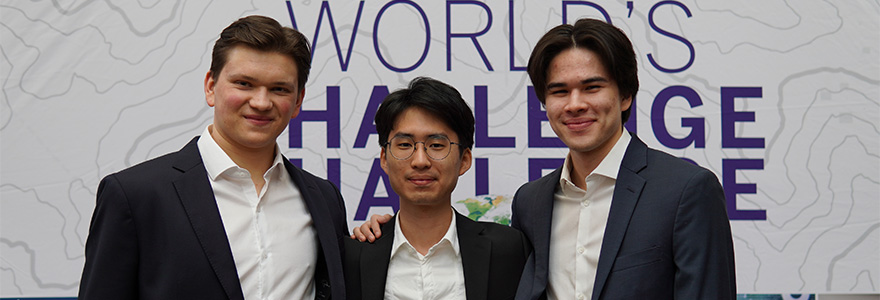A microscope that makes diagnosing malaria easier and cheaper

From left, Robin Cunningham, Justin Yang and Samuel Farnum.
By Communications
Intermittent electricity. Humidity. Prohibitively high costs for microscopes and materials. Too few trained technicians to analyze blood samples in remote areas. Lack of rural health care sites.
When it comes to diagnosing malaria in rural and resource-constrained places in Africa, there are many barriers to confirming a potentially deadly disease by analyzing blood samples with a traditional microscope.
But one group of Western students is working on a low-cost microscope to make diagnosing malaria cheaper and more efficient – and they’ll face off next week against 12 other international student teams for a $30,000 funding prize as Western’s entry in the World’s Challenge Challenge.
“Nearly 250 million cases of malaria are diagnosed every year, with more than 700,000 deaths, including many who are children,” said Justin Yang, who recently graduated from Schulich School of Medicine & Dentistry’s Bachelor of Medical Sciences program, and is part of Western’s ‘Team ParaSight.’
“Rural villages have the most cases of malaria, for a variety of reasons – from a lack of pathologists to review the blood samples, to the prohibitive costs of buying traditional microscopes. We’re trying to change that.”
Team ParaSight is developing a laboratory-grade pathology microscope for a fraction of the cost, powered by computational imaging, said Yang. The team also includes Robin Cunningham, who just completed his fourth year of a dual degree in Mechatronic Systems Engineering and Medical Biophysics, and Samuel Farnum, who just finished his fourth year in Mechatronic Systems Engineering and the Ivey HBA Program.
“Our digital microscope prototype can be manufactured for around $200, compared to microscopes that are typically used to diagnose malaria, which cost between $10,000 and $20,000,” said Yang, who will enter Schulich Medicine’s MD program in the fall. “At the same time, we are also improving the microscope’s performance. So, the quality is being improved while the cost is dramatically lower.”
The team is affiliated with Western’s Frugal Biomedical Innovations (FBI) Program, a multi-disciplinary initiative designed to develop medical technologies that improve health care access for patients in remote and low-resource places.
View this post on Instagram
ParaSight initially stemmed from Yang’s participation in a summer research project led by Ian Cunningham, a professor in the Department of Medical Biophysics and Division of Medical Imaging and Biomedical Engineering. Working with Academics Without Borders and in collaboration with William Wasswa, a professor from Mbarara University of Science & Technology in Uganda, Professor Cunningham’s team was specifically focused on developing a low-cost digital light microscope for remote diagnosis of malaria.
The ParaSight student trio took the concept to the next level, by identifying the specific technologies required to make the microscope even more accessible in a low-cost context.
“I was going through the literature to see if there are any modalities or specific techniques that we can implement to reduce the cost of our device and one of the algorithms that I came across was ‘Fourier ptychography,’ which our prototype is based on,” said Yang.
While traditional microscopes use only a single light source, the Fourier ptychography approach uses hundreds of LED lights, which can capture much more detailed images of blood smears. This increases resolution and makes it easier to see the malaria parasite in red blood cells.
Yang credits their Ugandan collaborators with providing ideas, skills, expertise and knowledge of their communities’ needs to develop a product that has high potential to address their distinct challenges.
“We absolutely couldn’t do this without them,” he said.
Collaborators here and in Uganda already have functioning prototypes for the microscope, and the team is also looking ahead to a potentially game-changing way of incorporating AI into its design – which would enable diagnosis on the spot, lowering the need for a pathologist to examine slides and diagnose every case.
“It can take up to two hours for a trained pathologist to diagnose malaria, and the costs associated with that are very high – not to mention, these professionals just aren’t available in remote communities,” said Yang. “Down the road, we see potential for AI to detect whether a patient has malaria or not, right on the spot.”
ParaSight’s low-cost, sustainable solution for diagnosing malaria already garnered them attention when they won Western’s local World’s Challenge Challenge competition in the spring.
Now, they’re ready to compete against other students from around the globe for a $30,000 prize – which would go a long way toward helping them reach their goal of having a minimum viable product complete by the end of this year.
“What we have now is a prototype, but it’s just the microscope. It works great for research, but we need to make some modifications to turn it into a single, self-contained product you can use in any environment,” said Cunningham. “We are working on translating the software into a product, as well as making it functional as a single unit without needing a power supply.”
The team will pitch their solution to a team of judges at the World’s Challenge Challenge global finals at Western on Thursday, June 8 at 1 p.m.
Regardless of the outcome, the trio is looking forward to connecting with students from around the globe next week, as they participate in learning opportunities around sustainable development.
“I am most excited for the opportunity to meet with other individuals who come from drastically different backgrounds,” said Farnum. “This is an excellent chance to meet future global leaders of the world and learn notable lessons from students who can share diverse experiences.”
The Challenge was established 10 years ago as a way to encourage students to think big around solutions that address the United Nations Sustainable Development goals.
Attend the Global Final:
Join the World’s Challenge Challenge Global Final events on June 8 in person at Conron Hall or online by registering here.








